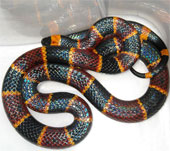June 22nd, 2011 by Paul Auerbach, M.D. in Health Tips
No Comments »

 Eastern coral snake, photo courtesy of Norman Benton, CC-BY-SA 3.0
Eastern coral snake, photo courtesy of Norman Benton, CC-BY-SA 3.0
The Wilderness Medical Society held its annual meeting at Snowmass last summer July 23-28, 2010. There were numerous terrific educational sessions. In a series of posts, I am going to highlight some of what we learned from the presenters.
Jonathan Allen gave a presentation on venomous snakebite management. Here are some facts to remember:
Snakebite Statistics
Approximately 15 percent of the 3,000 snake species worldwide are dangerous to humans. There are annually 400,000 to 2,000,000 envenomations from snakebite worldwide, with 20,000 to 100,000 deaths. In the U.S., there is at least one species of venomous snake in every state except Alaska, Maine, and Hawaii. There are approximately 20 venomous species, including pit vipers and coral snakes, and an estimated 6,000 to 7,000 venomous snakebites each year, including six to 10 deaths. Perhaps only 20 percent of bites are reported.
Deaths from snakebites typically Read more »
This post, What You Need To Know About Snakebites, was originally published on
Healthine.com by Paul Auerbach, M.D..
March 21st, 2010 by Paul Auerbach, M.D. in Better Health Network, Health Tips, True Stories
No Comments »

Last spring there was a news story about a man who said he saved his dog’s life by sucking venom from a rattlesnake bite out of the animal’s nose. After he performed this lifesaving feat and took his dog to a veterinarian, he reportedly began feeling ill himself.
It is further reported that he went to a hospital and received four vials of antivenom. The dog reportedly had its head swell up to three times its normal size and it also was administered antivenom. The man and his dog recovered. Read more »
This post, Snake Bites: Should You Suck The Venom Out Or Not?, was originally published on
Healthine.com by Paul Auerbach, M.D..
February 27th, 2010 by Paul Auerbach, M.D. in Uncategorized
No Comments »

 When I was a medical student, I served a summer externship in 1975 with the Indian Health Service at Fort Belknap in Harlem, Montana. On some hot summer evenings, I went fishing at a place the locals called “Snake Lake,” which was loaded with cutthroat trout, and surrounded by rocky outcroppings that were home to scores of rattlesnakes. I was advised to stay away from the rocks, and to always wear long pants.
When I was a medical student, I served a summer externship in 1975 with the Indian Health Service at Fort Belknap in Harlem, Montana. On some hot summer evenings, I went fishing at a place the locals called “Snake Lake,” which was loaded with cutthroat trout, and surrounded by rocky outcroppings that were home to scores of rattlesnakes. I was advised to stay away from the rocks, and to always wear long pants.
In the December, 2009 issue of the Annals of Emergency Medicine (Ann Emerg Med 2009;54:830-836), there appeared an article reporting a study by Shelton Herbert, PhD and William Hayes, PhD entitled “Denim Clothing Reduces Venom Expenditure by Rattlesnakes Striking Defensively at Model Human Limbs.” The purpose of the study was to determine whether ordinary clothing (denim material from blue jeans) interferes with the kinematics of venom delivery, thereby reducing the amount of venom injected by a typical snake into a (model) human limb. Read more »
This post, Blue Jeans May Offer Protection From Rattlesnake Bites, was originally published on
Healthine.com by Paul Auerbach, M.D..
October 24th, 2009 by Paul Auerbach, M.D. in Better Health Network, Health Tips
No Comments »

 This is the next post based upon my presentation given at the Wilderness Medical Society Annual Meeting held in Snowmass, Colorado from July 24-29, 2009. The presentation was entitled “Just When You Thought It Was Safe to Go Back in the Water.”” The topic was an overview of hazardous marine animals and it was delivered by me. In the previous post, there was information about shark attacks. In this post, there is information about envenomations incurred in the marine environment.
This is the next post based upon my presentation given at the Wilderness Medical Society Annual Meeting held in Snowmass, Colorado from July 24-29, 2009. The presentation was entitled “Just When You Thought It Was Safe to Go Back in the Water.”” The topic was an overview of hazardous marine animals and it was delivered by me. In the previous post, there was information about shark attacks. In this post, there is information about envenomations incurred in the marine environment.
Marine venoms, similar to other toxins and poisons that originate in the animal and plant kingdoms, may cause a wide range of human physiological derangements. It is very important to remember that certain of these venoms, such as that elaborated by jellyfish, may invoke a serious allergic reaction.
Stingrays are a commonly incriminated group of envenoming animals. There are more than 10 species found in U.S. coastal waters, with from 1 to 4 venomous “stings” found on the top of the caudal appendage (“tail’). The spine is a serrated cartilaginous structure that houses venom glands covered by a fragile tissue sheath. Thus, when the spine enters a human victim, most commonly on the lower limb (ray is stepped upon) or upper limb (ray is handled), the tissue sheath is disrupted and venom enters the wound. Thus the injury is just a puncture/cut and an envenomation. Read more »
This post, How To Treat Stingray Envenomation, was originally published on
Healthine.com by Paul Auerbach, M.D..
 Eastern coral snake, photo courtesy of Norman Benton, CC-BY-SA 3.0
Eastern coral snake, photo courtesy of Norman Benton, CC-BY-SA 3.0












